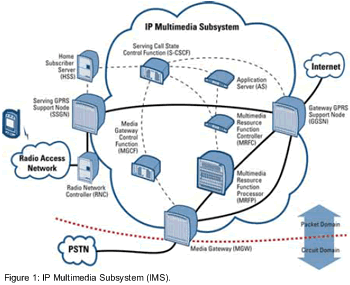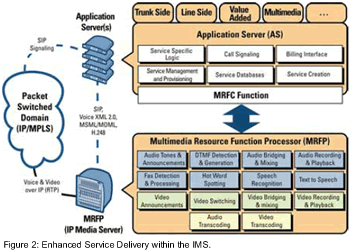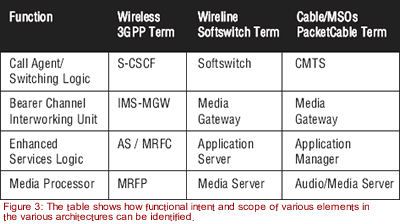
February 2005
IMS: The Catalyst For Service Convergence Across Wireless & Wireline Networks (Sidebar)
BY Grant Henderson
VoIP has quickly become a mainstream technology that is changing the face of modern telecommunications. VoIP is now the foundation of every leading wireless, wireline, and cable/MSO operator’s next generation network architecture, as well as a critical part of these operators’ corporate strategy for cost reduction, differentiation, and increased competitiveness. The IP Multimedia Subsystem (IMS), as defined by the wireless industry’s 3G Partnership Project (3GPP) is the most recent refinement of the enhanced services architecture — so much so that even wireline carriers are looking towards the IMS as the basis for achieving the nirvana of carrier operations: a single enhanced services architecture for delivering any service, using any media, to reach any customer, regardless of how they connect to the network.
Mobile Network Architecture & Standards
Historically, enhanced services have been deployed as a collection of point solutions and were delivered using a vertically integrated approach: an announcement server for network announcements, an IVR server for touchtone services, a conference server, a prepaid calling card server, and a voicemail server.
In 1998, a group known as the Third Generation Partnership (3GPP) was founded by a global consortium of standards bodies to define a next-generation mobile architecture that built on the success of GSM. 3GPP architects recognized that the traditional approach of deploying vertically integrated enhanced services was inefficient and set out to develop a horizontally layered architecture for enhanced service delivery. This new architecture was designed to minimize costs for the service provider, while supporting the universal delivery of enhanced services, regardless of the access technology used by subscribers to reach those services. The 3GPP subsystem responsible for enhanced services is known as IMS.
 The key components of the IMS are shown in Figure 1. The Serving Call State Control Function (S-CSCF) provides the centralized “brains” of the IMS through interactions with the various service platforms. The S-CSCF maintains session state, while interacting with the gateways, service platform elements, and charging functions for the overall orchestration of service delivery. The Home Subscriber Server (HSS) continues its role as the main data storage for all subscriber and service-related data. Interworking with the PSTN and Internet is provided by various gateway elements defined by the 3GPP — namely the Media Gateway (MGW) for the PSTN or earlier-generation wireless networks, and the Gateway GPRS Support Node (GGSN) for connectivity with the Internet. The key components of the IMS are shown in Figure 1. The Serving Call State Control Function (S-CSCF) provides the centralized “brains” of the IMS through interactions with the various service platforms. The S-CSCF maintains session state, while interacting with the gateways, service platform elements, and charging functions for the overall orchestration of service delivery. The Home Subscriber Server (HSS) continues its role as the main data storage for all subscriber and service-related data. Interworking with the PSTN and Internet is provided by various gateway elements defined by the 3GPP — namely the Media Gateway (MGW) for the PSTN or earlier-generation wireless networks, and the Gateway GPRS Support Node (GGSN) for connectivity with the Internet.
 Enhanced Service Delivery Within The IMS Enhanced Service Delivery Within The IMS
The key elements of the IMS architecture as it pertains to enhanced service delivery are the Application Server (AS), the Multimedia Resource Function Controller (MRFC), and the Multimedia Resource Function Processor (MRFP). Figure 2 shows their relationship and their respective functionality.
The Application Server (AS) is responsible for the execution of service-specific logic, for example call flows, database dips, and user interface interactions with subscribers. The AS delivers value-added services to the IMS, such as push-to-talk, ringback tones, prepaid calling card, multimedia conferencing and multimedia messaging service logic. The Multimedia Resource Function Processor (MRFP) — more commonly known as the IP Media Server — provides adjunct media processing for the application layer such as audio mixing, DTMF digit collection, content recording and playback, and codec transcoding.
Unlike traditional service delivery approaches however, the MRFP is not dedicated to a single application but provides media processing as a shared resource to a multitude of applications. The Media Resource Function Controller (MRFC) provides a media resource broker function between the AS and MRFP resources in the IMS, and can be implemented as part of an application server or as a separate network element.
In an IMS-compliant service delivery platform, the enhanced service components communicate via industry-standard and open interfaces such as SIP. This allows service providers to mix and match best-in-class Application Servers with best-in-class MRFP/Media Servers, and eliminates some of the traditional cost and feature inertia associated with legacy service node approaches to enhanced services.
Applying 3GPP IMS To Fixed Line Networks
Historically there has been very little opportunity to share technologies across fixed and mobile networks, especially at the enhanced services layer. However today, the architectures defined by the wireless operators (i.e., 3GPP IMS), wireline operators (i.e., Multiservice Switching or Softswitch), and cable network operations (i.e., PacketCable Multimedia) share a great number of common goals, principles, and standards including the following:
- SIP is commonly specified for the end-to-end signaling.
- Application and call signaling logic is separate from the media processing functionality.
- Media servers are intended to be multi-service, multi-protocol, sharable resources for any voice or video service.
- SIP, along with XML-based scripting languages, are gaining momentum as the preferred control signaling between the Application Servers and MRFPs/Media Servers.
 This level of common objectives and standards has resulted in a relatively clean mapping between the various functional elements across the standards. Although the nomenclatures differ, the functional intent and scope of various elements in the 3GPP IMS, Multiservice Switching, and PacketCable Multmedia architectures can be mapped as shown in Figure 3. This level of common objectives and standards has resulted in a relatively clean mapping between the various functional elements across the standards. Although the nomenclatures differ, the functional intent and scope of various elements in the 3GPP IMS, Multiservice Switching, and PacketCable Multmedia architectures can be mapped as shown in Figure 3.
The commonality of these architectures offers service providers deploying VoIP a relatively easy migration path for adding mobility to their plans. In addition, since enhanced services developed to the IMS architecture can easily span fixed and mobile networks, equipment and software vendors gain a larger addressable market with a single common product development effort.
Industry Movement Towards Wireless Standards
A number of VoIP industry leaders, including British Telecom and Sprint, are ensuring that support for next-generation wireless services is a key consideration in their next-generation enhanced service architectures.
In the case of service providers like Sprint who operate both fixed and mobile networks, adopting a wireless-centric architecture is natural given their desire to create a common network infrastructure for both businesses, and the desire to deliver a common set of value-added services to customers regardless of whether they use a fixed or mobile handset.
In the case of service providers like British Telecom, who currently offer only fixed-line services, adopting a wireless-centric service architecture helps future-proof their network and enables them to enter the mobile market as new VoIP-friendly access technologies such as WiMax emerge. In fact, British Telecom is taking a leadership position in helping drive the industry towards this outcome through its involvement in the Fixed Mobile Convergence Alliance (FMCA) and its highly publicized BluePhone initiative.
Conclusions
The 3GPP initiatives around the IP Multimedia Subsystem (IMS) architecture have received a great level of interest amongst telecommunication carriers — even amongst the traditionally distinct wireline and cable network segments of the carrier market. The common principles and similarities shared between the various next-generation service architectures offer an unprecedented opportunity to achieve true convergence across services, media, and access technologies. Industry-wide adoption of unifying standards such as IMS will allow service providers to increase the applicability of their service offerings to broader market segments and achieve scale economies in the delivery of those services, while allowing subscribers to experience a level of unification that was simply impossible in earlier-generation networking technologies.
Grant Henderson is co-founder and executive vice president of marketing and strategy at Convedia Corporation. For more information, please visit the company online at www.convedia.com.
[ Return To The February 2005 Of Contents ] |

